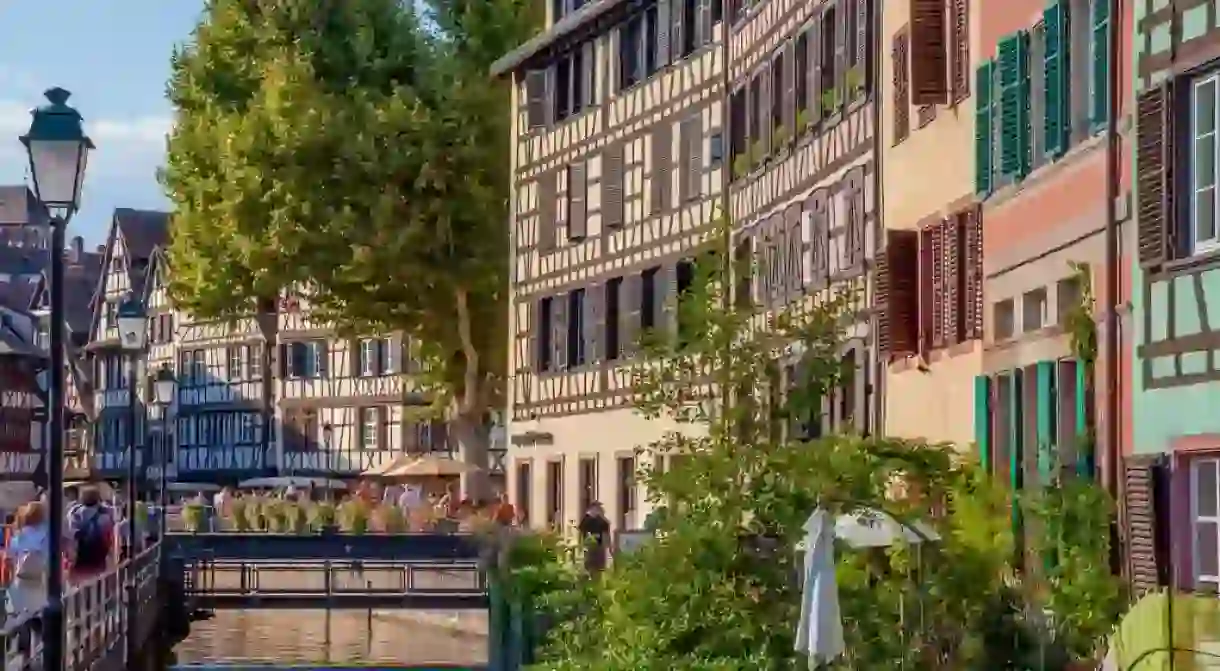The Perfect Walking Guide to Strasbourg

With a long and tumultuous history, even changing hands between France and Germany a few times, Strasbourg is so packed with treasures that the whole historical centre, an island formed by the river Ill, has been protected as a World Heritage Site. Follow this walking tour to uncover the town’s secrets.
Map:
A • Strasbourg Cathedral
You can’t miss the start of the itinerary as it is the most recognisable and impressive building (and the highest), visible from virtually anywhere you are in the Grand Îsle. Strasbourg’s Cathedral de Notre-Dame is known as one of the most beautiful in Europe. Building started in 1015, but was destroyed by fire, so by the time the ‘new’ cathedral was rebuilt in the 12th century, Gothic architecture had started to catch on. There is much to see here such as the stained glass windows dating from the 12th to the 14th century, and a very popular curiosity, the astronomical clock with its ingenious automated mechanism. An optional climb up the 332 steps is a bit strenuous but worth it to take in the panoramic view from the viewing platform.

B • Musée de l’Œuvre-Notre-Dame
Continue the exploration of the magnificent Cathedral in the museum dedicated to its contruction just a few steps across the square in a charming series of buildings dating from the 14th and 16th centuries. Besides some of the finest masterpieces of medieval sculpture, obtained from the cathedral, there are rooms devoted to the Renaissance period and the 17th century.
C • Palais Rohan
Walk next-door and move up a century, the 18th century that is, at the Palais Rohan. Designed to resemble one of the great Parisian mansions, the Strasbourg’s episcopal palace is one of the grandest buildings found directly on the water. Today it houses three of the city’s finest museums: the Musée des Beaux-Arts, the Musée Archéologique and the Musée des Arts Décoratifs. This would be a good time to think of stopping for lunch as you are in the perfect location surrounded by traditional winstubs (local brasseries) and gourmet restaurants around the Cathedral square.

D • Cave Historique des Hospices de Strasbourg
A longer walk after lunch takes you to the old hospital with its world famous wine cellars. The vineyards were donated over the years by the patients as a form of payment for medical services rendered. Today it is still a functioning cellar to age selected local wines, and is also home to a museum with a wine press dating from the 17th century. While there, look at the barrel that is still filled with one of the oldest wines in the world, dating from 1472.

E • Petit France
Take any of the meandering little streets around Petit France in the general direction of Rue des Moulins. You will come across one view prettier than the next, as the old half-timbered homes of fishermen, millers and tanners that once lived and worked here have been beautifully preserved.
F • Barrage Vauban
Just a few metres from the covered bridges you will come across the Vauban dam built in 1690, making it so that the entire southern end of the town could be flooded if needed. There’s a lovely terrace from which to appreciate the quiet beauty of the architecture and the engineering that went into building the network of canals.

G • Place Kléber
A perfect time to stop for coffee and a pastry to recharge the batteries. Once you reach this large square right in the heart of the city, you will find the best shopping addresses in town. The pedestrianized Place Kléber square is also the location of one of the most charming Christmas markets.

H • Kammerzell House, Place de la Cathédrale
Circling back to the starting point in the Cathedral square, take a moment to admire the house on the corner that bears the name of the grocer Kammerzell. The original floor dates as far back as the 15th century, with a jaw-dropping façade that draws visual elements taken from Biblical inspiration, Greek and Roman style and Medieval times.













